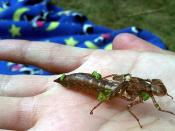Different people choose to live their lives differently than others. In the poem, "The Passionate Shepherd To His Love," by Christopher Marlowe, the shepherd fantasizes to his love. In "The Nymph's Reply to the Shepherd," by Sir Walter Ralegh, the nymph is more aggressive and realistic. The nymph views life more skeptical than the shepherd. The shepherd's way of life is Carpe Diem where as nymph's state of mind is more like Tempus Fugit. She believes that time flies and dreams are bitter. The shepherd's tone is innocent while devoid of complications. The authors in both poems use different dictions although Ralegh repeats some of the words that Marlowe uses in his poem.
When the shepherd speaks to his love, he has a unique choice of words. Words used like myrtle meaning a shrub, kirtle representing a dress, and posies indicating a bouquet. The nymph uses repetition of diction.
In the poem by Marlowe, the reader sees "A belt of straw and ivy buds,/ With coral clasps and amber studs;" (Christopher Marlowe, 16-17). On the contrary, in the other poem the lines, "Thy belt of straw and ivy buds,/ Thy coral clasps and amber studs," (Sir Walter Ralegh, 16-17). She shows that rustic life is too simple and impractical, too innocent for a real people. The shepherd's poem to his love is less realistic because it assumes that love comes easily and stays forever. On the other hand, the nymph's reply is a slap in the face showing him that time does not seem to stay. The nymph believes that after time love dies, things change and people are forgotten. The shepherd approaches life by Carpe Diem, literally meaning, seize the day. The nymph on the other side, believes that...


